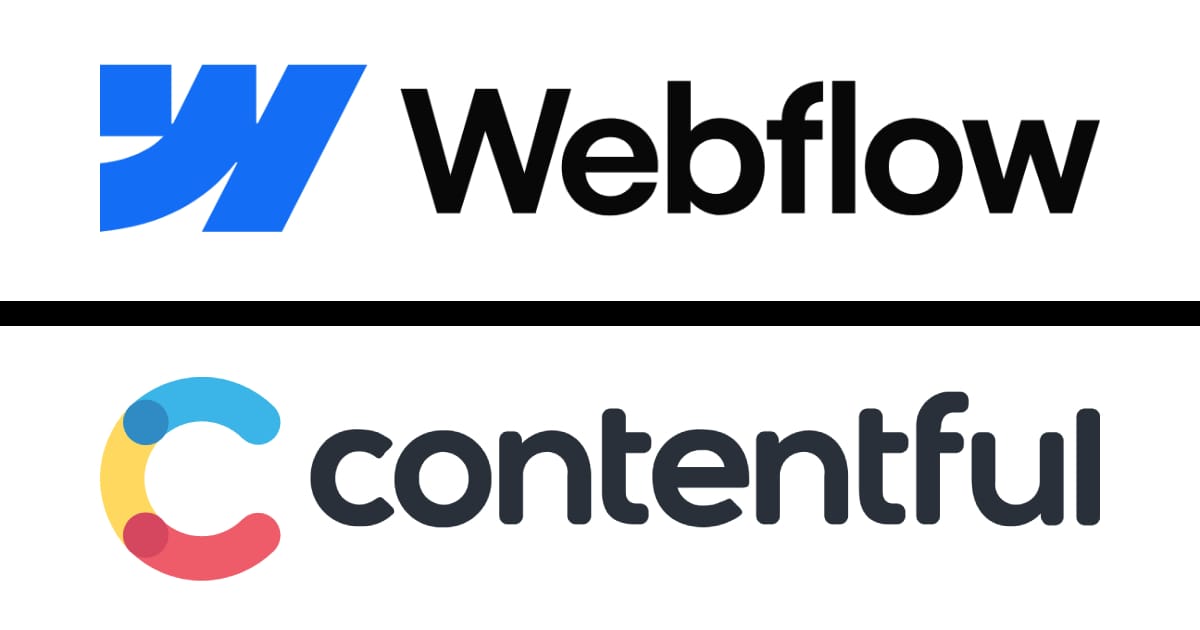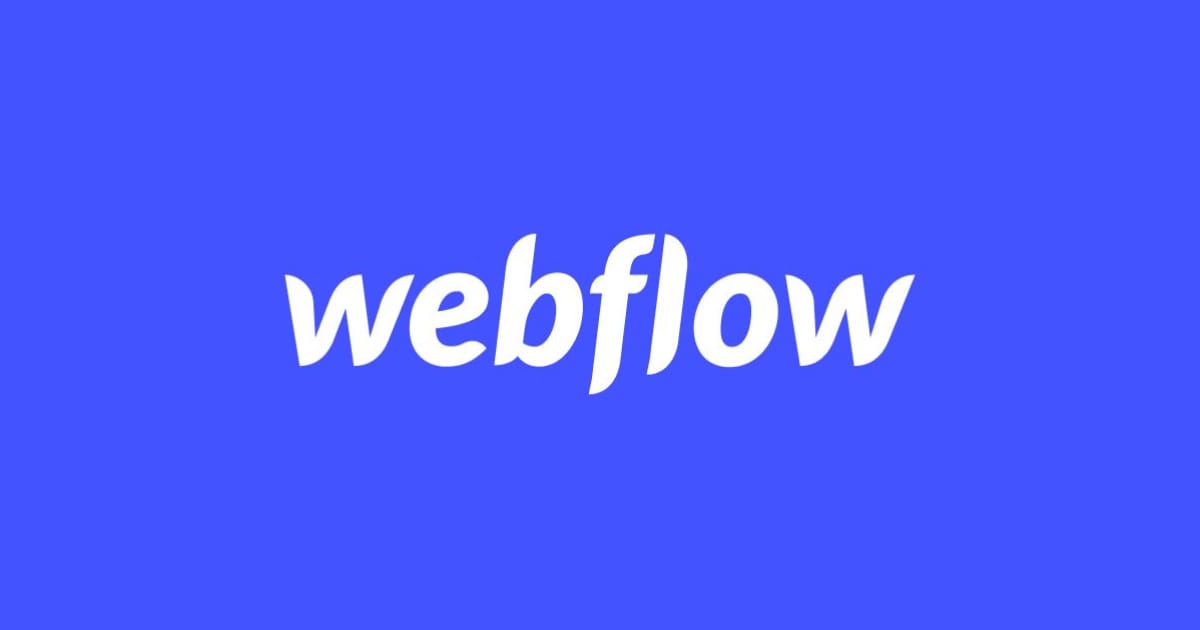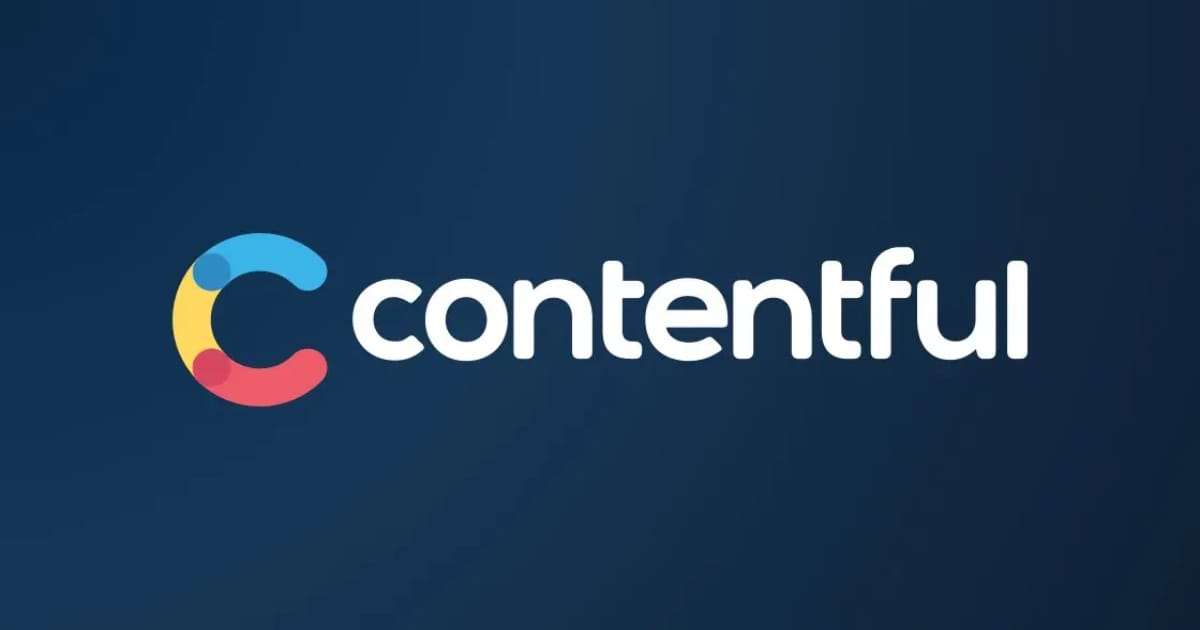Webflow vs Contentful - Which is Best? (2025)

In web development and digital content creation, selecting the right content management system (CMS) is crucial for online success. Webflow and Contentful are two prominent platforms, each offering distinct advantages tailored to different needs. This comprehensive comparison illuminates the strengths and weaknesses of both, guiding you towards an informed choice based on your specific requirements.
Whether building a website, managing complex content strategies, or scaling your online business, understanding Webflow and Contentful's capabilities is the first step towards achieving your digital aspirations.
What is Webflow?

Overview and History
Webflow, founded in 2013 by Vlad Magdalin, Sergie Magdalin, and Bryant Chou, is a groundbreaking SaaS platform that revolutionizes the way websites are designed and built. It offers a visual design tool that enables users to create responsive websites without needing to write code, though it also supports custom HTML, CSS, and JavaScript for advanced functionality. Originating from an idea that took years to materialize, Webflow launched its public beta to considerable acclaim, providing a bridge between design and development. Over time, it expanded its services to include content management, e-commerce, and hosting, catering to a wide range of users from novices to professionals in web design and development. Its innovative approach and comprehensive features have made it a popular choice for building and managing websites.
Key Features and Services
Webflow is a web design and hosting platform that combines several key features and services, making it unique among website building and hosting services. Here are its main features:
- Visual Web Design Tool: Offers a user-friendly, drag-and-drop interface for designing websites visually without the need for coding, alongside options for custom code for advanced functionalities.
- Responsive Design: Automatically ensures websites are responsive, providing an optimal viewing experience across all devices.
- CMS Functionality: Features a powerful Content Management System that lets users create and manage content dynamically, designed for both developers and non-technical users.
- E-commerce Support: Provides built-in tools for building and managing online stores, including product management and payment processing.
- Hosting Services: Delivers fast and secure web hosting with automatic scaling and SSL certificates, powered by Amazon Web Services (AWS).
Fees and Pricing Structure
Webflow offers a variety of pricing plans, catering to different needs such as site plans for individual websites and account plans for designers and teams. Here's a general breakdown:
- Site Plans: These are specific to each website you build and host with Webflow and are divided into two main categories:
- Basic Plan: $14/month, suitable for simple sites that don't require a CMS.
- CMS Plan: $23/month, designed for blogs or other content-driven sites, offering full CMS capabilities.
- Business Plan: $39/month, for higher traffic sites needing more resources.
- Ecommerce Plans: $29/month, tailored for online stores, available in different tiers to accommodate the size and volume of transactions.
- Workspace Plans: These plans are for individuals or teams creating multiple projects in Webflow and need access to more features.
- Starter Plan: A free tier that allows a limited number of projects and provides basic features.
- Lite Plan: $19/month, offers more projects and higher limits, including code export, ideal for freelancers and solo designers.
- Pro Plan: $49/month, aimed at active freelancers and agencies needing more advanced features, including site password protection and team collaboration tools.
- Team Plan: Custom, designed for teams, offering collaborative features and billing options.
Each plan has its own set of features, limitations, and pricing, which can vary based on the specific needs such as the number of monthly visits, CMS items, or ecommerce functionalities required. It's important to check Webflow's official website for the most current pricing information, as they frequently update their plans and features to better serve their user base.
Pros
- Visual Design Editor: Webflow’s visual editor allows for designing and launching websites without coding knowledge, making it accessible to designers and those familiar with graphic design software.
- Responsive Design Capabilities: It provides tools for easily creating responsive designs that work on all devices, ensuring a great user experience across the board.
- Integrated CMS and Hosting: Webflow offers an all-in-one solution that includes web hosting and CMS capabilities, streamlining the process of designing, launching, and managing websites.
- SEO Features: The platform has built-in SEO tools that help improve your website’s visibility on search engines, without needing to install additional plugins.
- High Customization Potential: Users can achieve highly customized designs and functionalities, thanks to Webflow’s advanced design options and ability to inject custom code.
- E-commerce Support: Webflow supports e-commerce capabilities, allowing users to design, build, and launch online stores within the same platform.
Cons
- Learning Curve: Despite the drag-and-drop interface, there's a learning curve, especially for those who are new to web design or unfamiliar with design software.
- Pricing: While there is a free plan, advanced features, hosting, and higher site traffic capabilities come with premium plans, which can get expensive.
- Limited Content Distribution: As a traditional, albeit advanced, CMS, it doesn’t offer the same level of content distribution flexibility as a headless CMS like Contentful.
- Template Dependency: While you can create a site from scratch, many users rely on templates, which can limit creative freedom or result in websites that look similar.
- Performance Optimization: Users have less control over technical aspects like loading times and optimization, especially compared to manually coded websites or those optimized through a headless CMS.
- E-commerce Functionalities: While Webflow supports e-commerce, its features may not be as comprehensive or customizable as those offered by platforms dedicated solely to e-commerce.
Ideal Use Cases and Target Audience
Webflow is ideal for designers, freelancers, agencies, and small to medium businesses looking to design, build, and launch websites without deep coding knowledge. It suits those needing a visual editor for responsive design, integrated CMS for content management, and e-commerce capabilities. Webflow's target audience includes professionals seeking an all-in-one solution to streamline the web development process while maintaining design flexibility and control.
Companies using Webflow
- VICE
- Orange Theory
- Philips
- The New York Times
- Upwork
- PWC
- Discord
- Freshly
- Dropbox
- Michael Kors
- Monday.com
- TED
What is Contentful?

Overview and History
Contentful is a headless content management system (CMS) launched in 2013 in Berlin, Germany, by Sascha Konietzke and Paolo Negri. Initially released the same year, it was initially called "Storageroom." The platform is recognized for its headless approach, avoiding traditional CMS terminology. Contentful has grown significantly, securing substantial funding over the years, including a notable $175 million in 2021 led by Tiger Global, valuing the company at $3 billion. Its headquarters are in San Francisco, California, with additional offices in Denver, Colorado, and Berlin.
Key Features and Services
Contentful is a headless Content Management System (CMS) that offers a range of features and services designed to streamline the creation, management, and distribution of content across various platforms. Here are its key features:
- Headless CMS: Allows managing content separately from where it's displayed, enhancing flexibility across different platforms.
- Multi-Channel Delivery: Enables content to be used across websites, apps, and other digital platforms without redundancy.
- API-First Approach: Offers robust APIs for managing and delivering content dynamically, suitable for modern web architectures.
- Marketplace for Apps: Provides a platform for third-party and in-house apps, extending Contentful's capabilities.
- Public APIs for Development: Encourages the creation of custom apps by making APIs publicly available, fostering a developer-friendly ecosystem.
Fees and Pricing Structure
Contentful offers a range of pricing options tailored to different needs, starting from a free Community Plan up to custom pricing for the Enterprise Plan. The details are as follows:
- Community Plan: This is a free option, ideal for individual developers working on personal sites, hackathons, or philanthropic projects. It provides API keys to get started with Contentful's capabilities.
- Team Plan: Priced at $300/month, this plan is designed for small teams working on one or two digital projects. It includes more features and support than the Community Plan.
- Enterprise Plan: Custom, this plan offers custom pricing and is aimed at larger organizations needing to scale up their content platform across multiple teams or the entire business. It includes all features of Contentful tailored to the organization's specific needs.
For more detailed information on pricing and to select the plan that best suits your needs, you can visit Contentful's official pricing page.
Pros
- Platform Agnosticism: Contentful's headless architecture allows for content to be used across any channel or platform without being tied to specific technology stacks.
- Quick Deployment and Distribution: Its CDN-backed setup ensures fast content deployment and distribution, with low-latency worldwide access.
- Strong Versioning and Rollback: Offers robust versioning and the ability to easily revert to previous content states, adding a safety net for content editors.
- High Uptime and Scalability: Designed to provide high uptime and scale alongside your project's growth without substantial architecture changes.
- Rich Ecosystem and Community: Benefits from a vibrant community, extensive tutorials, plugins, third-party tools, and solid documentation.
Cons
- Requires API-First Knowledge: To fully leverage Contentful's capabilities, a solid understanding of API-first development is necessary, which can be a hurdle for teams unfamiliar with this approach.
- Content Modeling Complexity: Designing your content model requires a deep understanding of your data structure needs, which can become complex.
- Not Ideal for Complex E-commerce: While it can support e-commerce, Contentful may not be the best fit for complex e-commerce solutions without additional backend logic.
- API Rate Limits: The platform imposes API rate limits, which could be a drawback for high-traffic sites or applications.
- Additional Costs: Advanced features may necessitate opting for paid plans, increasing overall costs.
Ideal Use Cases and Target Audience
Contentful is ideal for teams and individuals managing digital content across multiple channels, combining the flexibility of a headless CMS with user-friendly features for non-technical users. Perfect for developers, digital marketers, and content creators, it supports dynamic web applications, global content distribution, and marketing campaign management with ease. Its broad appeal lies in simplifying content updates and integrations, making it a versatile choice for projects ranging from small blogs to enterprise applications.
Companies using Contentful
- Spotify
- Kraft Heinz
- KFC
- Vodafone
- BMW
- Urban Outfitters
- Aldo
- EA (Electronic Arts)
- Shutterfly
- Plaid
- Staples
- Bang & Olufsen
Ease of Use
When it comes to choosing a CMS, ease of use is a crucial factor for many users, especially those with limited technical expertise. Webflow and Contentful cater to different audiences, which is reflected in their user interfaces and overall user experience.
Webflow
Webflow's visual editor is designed with designers and visual thinkers in mind, making it highly intuitive for those familiar with design software like Adobe Photoshop or Sketch. The drag-and-drop interface simplifies the web design process, allowing users to see changes in real-time without needing to code. However, the vast array of options and controls can be overwhelming for complete beginners, suggesting a slight learning curve for those new to web design and development.
Contentful
Contentful, being a headless CMS, focuses more on the content management aspect, providing a clean and straightforward user interface for managing content. It's designed for users who are comfortable working with content structures and APIs, making it more developer-friendly. The lack of a visual design interface means that non-technical users might find it challenging to visualize the end product without the help of a developer.
Design and Flexibility
The design capabilities and flexibility of a CMS are vital for businesses that need a customizable online presence.
Webflow
Webflow offers extensive design flexibility, allowing users to create unique websites without any template restrictions. The platform’s strength lies in its ability to let users design for responsiveness, adjusting layouts for different screen sizes using a visual editor. This flexibility, however, comes with the requirement of having a good grasp of design principles to make the most out of the platform.
Contentful
As a headless CMS, Contentful offers ultimate flexibility in how content is presented, but it does not provide design tools or templates. The platform is built to integrate with any design framework or development environment, granting developers the freedom to design in the environment they prefer. This approach requires a separate design and development process, which can be more flexible but also more complex than using a visual editor like Webflow's.
Content Management and Scalability
For businesses planning to scale, the ability to manage content efficiently and integrate with other tools is key.
Webflow
Webflow’s CMS functionality allows for easy content management within its visual design environment. It is suitable for small to medium-sized enterprises and handles scalability within its ecosystem well, offering different hosting plans to accommodate growing traffic and content needs. However, because it's a coupled CMS, its content management capabilities are inherently tied to the design and development within Webflow, which might limit flexibility in distributing content across different platforms.
Contentful
Contentful excels in managing and scaling content for large, complex websites and applications. Its API-driven approach means content can be created once and published anywhere, from websites to mobile apps, making it incredibly scalable and flexible. Contentful is designed to work seamlessly with other tools and services, offering integrations with various third-party applications, which can significantly enhance workflow and productivity for larger teams.
Final Thoughts
The choice between Webflow and Contentful hinges on your project's requirements, technical prowess, and long-term digital strategy. Webflow excels as a visually-driven design and development tool, providing an intuitive platform for crafting responsive, high-quality websites without delving into code. It appeals to designers, freelancers, and small-to-medium businesses seeking an all-encompassing solution for web design, CMS, and hosting.
Conversely, Contentful shines with its flexibility and scalability, particularly in complex projects demanding content distribution across multiple platforms. Its headless CMS approach benefits developers and larger organizations aiming to tailor digital experiences precisely, integrating seamlessly into any design and development workflow.
Ultimately, your selection should align with your specific needs: assess your team's technical capabilities, project complexity, and plans for managing and scaling digital content. Both platforms offer robust solutions but cater to different web development and content management spectrums. By harmonizing your decision with project goals and technical requirements, you'll choose the platform best suited to support your vision for a successful online presence.
If you need help moving your current website to Webflow or Contentful, reach out to us and we can build it for you.
Key Takeaways
| Feature | Webflow | Contentful |
|---|---|---|
| Target Audience | Designers, freelancers, agencies, small to medium businesses | Developers, larger organizations |
| Ease of Use | Visual editor, intuitive for those with design software experience | More developer-friendly, requires technical knowledge |
| Design & Flexibility | High design flexibility with visual editor, suitable for responsive web design | Ultimate flexibility in design and development through API integration |
| Content Management | Integrated CMS for website content, less flexible for multi-platform distribution | Headless CMS, highly flexible for multi-platform content distribution |
| Scalability | Suitable for small to medium-sized projects, scalable within Webflow’s ecosystem | Built for scalability across various platforms and complex projects |
| Pricing | Free tier available, paid plans based on site features and usage | Free tier for small projects, scalable paid plans for larger needs |
| Support | Comprehensive support across all plans, priority support for higher-tier plans | Documentation and community support for all, dedicated support for paid and enterprise plans |





